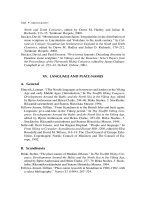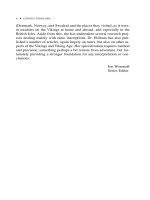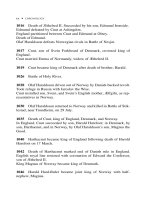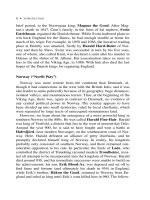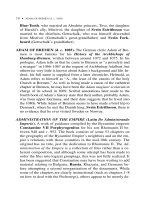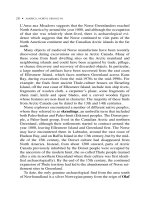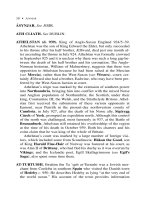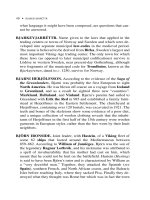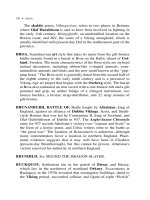The A to Z of the Vikings 7 pps
Bạn đang xem bản rút gọn của tài liệu. Xem và tải ngay bản đầy đủ của tài liệu tại đây (67.38 KB, 10 trang )
ÁSYNJAR. See ÆSIR.
ATH CLIATH. See DUBLIN.
ATHELSTAN (d. 939). King of Anglo-Saxon England 924/5–39.
Athelstan was the son of King Edward the Elder, but only succeeded
to his throne after his half brother, Ælfward, died just one month af-
ter ascending the throne in July 924. Athelstan was formally crowned
in September 925 and it is unclear why there was such a long gap be-
tween the death of his half brother and his coronation. The Anglo-
Norman historian, William of Malmesbury, suggests that there was
opposition to Athelstan because he had been raised at the Mercian
(see Mercia), rather than the West-Saxon (see Wessex), court; cer-
tainly Ælfward also had a brother, Eadwine, who may have been pre-
ferred by the West-Saxon faction at court.
Athelstan’s reign was marked by the extension of southern power
into Northumbria, bringing him into conflict with the mixed Norse
and Anglian population of Northumbria; the Scottish, under their
king, Constantine III; the Welsh, and the Strathclyde Britons. Athel-
stan first received the submission of these various opponents at
Eamont, near Penrith in the present-day northwestern county of
Cumbria, in July 927, after the death of his Norse ally, Sigtrygg
Cáech of York, prompted an expedition north. Although this control
of the north was challenged, most famously in 937, at the Battle of
Brunanburh, Athelstan still retained his overlordship of the region
at the time of his death in October 939. Both his charters and his
coins claim that he was king of the whole of Britain.
Athelstan’s court was marked by a large number of foreign visi-
tors, which included some from Scandinavia: Hákon the Good, son
of King Harald Fine-Hair of Norway was fostered at his court, as
was Alan II of Brittany, who had fled his duchy as it was overrun by
Vikings; and the Icelandic poet, Egill Skallagrimsson (see Egil’s
Saga), also spent some time there.
AT-TURTUSHI. Ibrahim ibn Ya ’qub at-Turtushi was a Jewish mer-
chant from Cordoba in southern Spain who visited the Danish town
of Hedeby c. 950. He describes Hedeby as lying “at the very end of
the world ocean.” His account of the town provides information
38 • ÁSYNJAR
about the religious practices of its inhabitants, who he describes as
worshippers of Sirius and a few Christians. He also discusses their
lifestyles—they apparently ate a diet of fish and possessed little prop-
erty or wealth—and their customs, which included the throwing of
unwanted newborn babies into the sea.
AUD THE DEEP-MINDED (ON Au
ðð
r in djúpú
ðð
ga). Also known as
Unn. Daughter of the most famous Norse Hebridean, Ketill Flat-
Nose, and wife of Olaf the White of Dublin. Following the death of
her father, husband, and her son, Thorstein the Red, Aud left the He-
brides for Iceland, where she established a family farm on Brei-
ðafjörður. Her family came to be known by the name Laxdale and
was the subject of a 13th-century saga, Laxdæla Saga.
– B –
BAFFIN ISLAND. See HELLULAND.
BALDER (ON Baldr). God of the Æsir family. Balder was the son of
Odin and Frigg and the husband of the goddess, Nanna. According
to the Prose Edda, Balder was the wisest, friendliest, and best of the
gods, praised by everyone and loved by everything; and “he is so
fair in appearance and so bright that light shines from him.” Balder
lived in the heavens, in Brei
ðablik, where nothing impure could be
found, and had a ship called Hringhorni and a ring called Draupnir.
Snorri’s Gylfaginning contains a long section about Balder’s death
and his funeral. Following a series of dreams and premonitions that
Balder had, in which his life was in danger, Frigg asked all things to
swear a promise not to harm her son. Only mistletoe, which Frigg be-
lieved was too young to take an oath, was spared from this process,
information that Loki then gained by tricking Frigg. He then per-
suaded Hod, a blind god, to throw the mistletoe at Balder, which
resulted in his death. Balder’s body was placed on his ship, and his
broken-hearted wife, Nanna, collapsed and died; they were both
burned in the funeral pyre that was lit on the ship, along with Balder’s
horse. Odin offered the goddess Hel a ransom for Balder and was told
that Balder would be allowed to return to Asgard if all things wept
BALDER •39
for him. However, a giantess called Thanks (ON
þ
ökk) refused, and
Snorri claims that this was Loki in disguise. Loki was punished for
Balder’s death and for preventing his return by being bound to a rock,
under the dripping fangs of a poisonous snake. According to the Ed-
dic poem, Balder’s Dreams, and Saxo Grammaticus’s History of
the Danes, Odin fathered a son (called Vali and Bous in the respec-
tive accounts) by a giantess called Rinda in order to avenge Balder’s
death. Saxo also describes Balder as an ancient Danish king, associ-
ated with the cult place at Lejre, and the same idea is also found in
the poem Bjarkamál, which may, however, also owe much of its con-
tent to Saxo.
In both the Prose Edda and the Eddic poem, Völuspá, an account
of Ragnarök immediately follows the details of Balder’s death and
Loki’s punishment. Balder is one of the few gods who survived Rag-
narök, along with his unwitting killer, Hod. This rebirth has been
likened by some scholars to the resurrection of Christ, suggesting
that the Balder myth was modified as a result of contact with Chris-
tianity.
BALLADOOLE. Site of a pagan Viking-Age ship burial from the
northern parish of Jurby on the Isle of Man. The ship, measuring
about 11 meters in length, had been placed in an early Christian
graveyard, surrounded by stones set in the shape of a ship. It con-
tained the remains of a man and woman, along with traditionally
male grave goods that included horse-harnesses, stirrups, spurs, and
a shield.
BALLATEARE. Site of a Viking-Age pagan burial from the southern
parish of Arbory on the Isle of Man. The burial mound contained the
remains of a man and a woman, although the grave goods were ex-
clusively “male” in character consisting of, among other things, a
sword in its scabbard, spears, knives, and the remains of a shield. The
male skeleton, probably aged between 20 and 25, had been placed in
a wooden coffin or a timber chamber, dressed in his cloak, which was
then covered in soil and turf. The cremated remains of cattle, horse,
sheep, and dogs were found near the top of the mound, along with a
female skeleton, aged between 20 and 30, whose skull had been
badly slashed as part of a ritual sacrifice.
40 • BALLADOOLE
BAYEUX TAPESTRY. The Bayeux Tapestry consists of eight separate
pieces of linen, embroidered with wool of eight colors that have been
joined together, giving a total length of 68.4 meters. The embroidery
depicts some 79 different scenes concerning the events that led to the
Battle of Hastings on 14 October 1066, when the English king,
Harold Godwinsson, was killed by an invading Norman army under
its duke, William II of Normandy. Above the scenes there are a num-
ber of Latin captions, explaining the sequence of events from when
Harold said good-bye to Edward the Confessor, king of England, be-
fore setting sail to Normandy from his manor in Bosham c. 1063–64,
until the flight of the defeated English from the battlefield in October
1066.
The tapestry is not mentioned in any written sources before 1476,
when it appears in an inventory of Bayeux Cathedral’s possessions,
and then there is a further silence of some 250 years before part of it
was sketched in 1724. The first complete picture of the tapestry was
published in Montfaucon’s Monuments de la Monarchie Française in
1728–1729. The work was very probably commissioned by a Nor-
man; certainly it portrays events from a Norman point-of-view,
although the workmanship appears to be English. An old French tra-
dition claimed that it was embroidered by William’s wife, Matilda,
but most scholars have rejected this theory. A strong case has instead
been made for Odo, Bishop of Bayeux and half brother of William
the Conqueror, as the patron of the tapestry. It has been argued
that the tapestry may have been produced in the English town of Can-
terbury, Kent (Odo was Earl of Kent 1067–1082), in the years imme-
diately after the Conquest, and that it was first displayed in public at
the dedication of Bayeux Cathedral in 1077. However, the Bayeux
Tapestry is primarily a secular “document” and the connection with
the Cathedral may be secondary.
The tapestry is of interest to historians of the Vikings because of
the picture it gives of Norman ships and shipbuilding, weapons and
warfare, some 150 years after Rollo established a Scandinavian
colony in Normandy.
BELOOZERO. Town on the River Volga in Russia where, according
to the Russian Primary Chronicle, Sineus, Rurik’s brother, settled
following the episode known as “The Calling of the Varangians.”
BELOOZERO •41
However, the figures of Sineus and Truvor, another so-called brother
of Rurik, are probably later literary inventions by the author of the
Chronicle, and so Beloozero’s connection with Rurik’s dynasty is of
doubtful historicity.
BERGEN (ON Björgvin “pasture land by the mountain”). The west-
ern Norwegian town and port of Bergen is first mentioned in written
sources in 1135, when the English monk Orderic Vitalis lists it in his
Historia Ecclesiastica as the first of six civitates or towns lying on the
Norwegian coast. Later sources date the town’s foundation to c. 1070
in the reign of King Olaf the Peaceful, but while Heimskringla sug-
gests that this was established on virgin land, Morkinskinna and
Flateyjarbók imply that Olaf simply formalized arrangements, regu-
lating a market place that was already in existence. Recent archaeo-
logical investigations around the harbor of Bergen have failed to
reveal any artifacts or structures predating the 1130s, but this can be
attributed to the fact that the Viking-Age shoreline lay approximately
140 meters behind the current harbor front. Current scholarly opinion
favors the model of a gradual organic growth of settlement around Vå-
gen, the inlet of the fjörd connecting Bergen to the North Sea, which
was later formalized by Olaf.
Certainly the rapid rise to prominence that Bergen enjoyed after its
“foundation” is suggestive of development before Olaf’s time: by the
1130s, the social, economic, and topographic structures of Bergen
were clearly those of a town; and the town seems to have played an
important role in the Norwegian civil war that began around that
time. There is also strong evidence for an earlier important royal es-
tate at Alrekstad in Bergen, mentioned in the saga of Harald Fine-
Hair, which is likely to have been an administrative, economic, and
possibly market center during the Viking Age, particularly as Vågen
was normally free of ice all year round.
We also know from Heimskringla that Olaf build a wooden
church, Christchurch, at Holmen in Bergen and laid the foundations
for the stone church that was to later become the cathedral; a list of
bishoprics, compiled around 1120, includes Bergen, and it probably
was derived from an earlier list dating to shortly after the year 1100.
By 1240, Bergen had been declared the capital of Norway, replacing
Trondheim, and King Hákon Hákonarson (d. 1263) built a royal
42 • BERGEN
hall (now called Håkonshallen) at the entrance to the town’s harbor.
Bergen thrived on the profits of exporting stockfish to England and
the Low Countries, and the Hanseatic League established a “count-
ing house” there in 1343. The German merchants of the Hanseatic
League lived in a quarter of the town called Tyskebryggen “the Ger-
man Wharf,” and had soon assumed total control of the trade from
Bergen. Excavations in and around Bryggen since the mid-1950s
have uncovered, among other things, over 600 runic inscriptions
(see rune) on wood and, to a lesser extent, bone and metal. These
have revolutionized runic studies by revealing a much more casual
use of the runic alphabet in everyday contexts than was previously
known.
BERSERKER (ON berserk, pl. berserkir “bear skin”). Name given
to Viking warriors who fought so fiercely in battle that they did not
need armor and did not feel pain. Snorri Sturluson describes this
battle fury in Ynglinga Saga: “his [Odin’s] men rushed forward
without armor, were as mad as dogs or wolves, bit their shields, and
were as strong as bears or wild bulls, and killed people at a blow, but
neither fire nor iron told upon themselves” (ch. 6). Although Snorri
Sturluson believed that the word was derived from ON berr “bare,”
meaning someone who fights without armor, it is more likely that a
berserker means “person wearing a bear’s skin,” and who thus took
on the characteristics of a bear in battle. In some sagas, such as the
Saga of Hrólfr Kraki, the berserker is even said to have taken on
the shape of a bear.
The earliest surviving reference to berserker is in Haraldskvæ
ð
i,a
skaldic poem composed by Thorbjörn hornklofi (“Horn-Cleaver” =
raven) for the Norwegian king, Harald Fine-Hair, in the late ninth cen-
tury and preserved in Snorri Sturluson’s Heimskringla. In this poem,
Harald is said to have had a troop of berserkers, who fought for him at
the Battle of Hafrsfjörd, and they are also described as or linked with
Úlfhe
ð
nar “men clad in wolf skins.” This connection between wolf and
bear is also apparent in other sources, such as Egil’s Saga. Egil’s grand-
father was known as Kveld-Ulf (“evening wolf”) and his father, Skalla-
Grim was a berserker. Both father and grandfather are depicted as being
uncontrollably violent at times: Kveld-Ulf’s rage leads to his death, and
Skalla-Grim almost kills his own son. The medieval Icelandic law-code
BERSERKER •43
Grágás penalizes berserkgangr (“going berserk”) with lesser outlawry,
and those people present at the time received the same sentence unless
they tried to restrain the man.
BIFROST (ON bifröst). Rainbow bridge that connects Asgard, the
home of the gods, with Midgard, where humankind live. The red in
the rainbow is said to be burning fire, to prevent unwanted visitors
from crossing into the heavens. According to Gylfaginning, Bifrost
is the most important bridge in the Norse cosmos. The etymology of
the word bifröst is uncertain: it may be derived from the ON verb bifa
“to sway, to shake,” but the Eddic poems, Grímnismál and Fáfnis-
mál, record the bridge’s name as bilröst, which means “fleetingly
glimpsed rainbow.” The Prose Edda tells us that the bridge was also
known as ásbrú, “bridge of the Æsir or gods,” because they rode
over it every day to their court at Unn’s Well (ON Ur
ð
arbrunnr). The
bridge was apparently built by the gods and its end in the heavens, at
Himinbjörg, was guarded by the god Heimdall. At Ragnarök, the
bridge is said to have collapsed as the sons of Muspell, probably gi-
ants, crossed the bridge to confront the gods.
BIRKA. Viking-Age town on the island of Björkö, Lake Mälaren, in
the Swedish province of Uppland (to the north of the modern capital,
Stockholm). Archaeological excavations suggest that the first inhab-
itants lived in Birka around the middle of the eighth century and that,
at its peak, the town consisted of a population of about 900 people
living in an area of c. 13 hectares. The town flourished until the end
of the Viking Age, when Sigtuna became the most important town on
Lake Mälaren. Birka was apparently abandoned toward the end of the
10th century, possibly due to the postglaciation rise in land levels in
eastern Sweden, which made access to Lake Mälaren via a portage at
Södertälje difficult.
Birka is one of the richest archaeological sites from Viking-Age
Scandinavia. More than 3,000 burial mounds and graves, both pagan
and Christian, have been found around the town. Excavations began
back in the 17th century, although the first large-scale excavations
took place in the 19th century, when over 1,000 burial mounds were
investigated. The finds from these burials reveal that during the
Viking Age, the town thrived on the profits of trade with the east, par-
44 • BIFROST
ticularly with Russia and the Islamic world: northern furs were ex-
changed for silver and silks from the East. These burials also provide
invaluable evidence of the transition from paganism to Christianity
in eastern Sweden, suggesting that the process of conversion pro-
ceeded slowly and that pagans and Christians lived side-by-side for a
considerable period of the town’s history. Excavations begun in 1990
concentrated on the town’s so-called “Black Earth” (this name is de-
rived from rich organic waste that has made the soil darker than that
elsewhere in the area). These excavations uncovered the town’s reg-
ular grid plan, with plots divided by ditches and paths. The wealth of
the town seems to have made it vulnerable to attack: in the ninth cen-
tury, a hill fort, Borg, was built on the southern edges of the town, and
in the following century, defensive walls were constructed around the
town and a wooden palisade was built in the harbor.
Rimbert’s Life of St. Ansgar provides us with some further details
of Birka’s history: the German missionary, Ansgar, visited the town
in 829, when it was under the rule of a king called Björn. Ansgar
stayed in the town for some 18 months, leaving a bishop and priests
behind him to continue the mission after his return to Bremen. How-
ever, shortly after his departure, the clergy was driven out of Birka
and at least one priest was killed. Although Ansgar did not return to
the town until the 850s, when another church was built for the town,
it is clear that Hamburg-Bremen continued missionary activity in
Birka as Archbishop Unni of Bremen died in Birka c. 936.
BIRSAY, BROUGH OF. Tidal island off the northwest coast of mainland
Orkney, Scotland, which was a center of political and ecclesiastical
power in the Northern Isles during the late Viking Age. The place-name,
Birsay, is derived from ON Byrgisey, “island of the byrgi,” and byrgi is,
in turn, a form of ON borg “enclosure.” This word can also be used
more specifically as “a place so shaped by nature that it can be easily
shut off,” thus a peninsula or narrow neck of land or even an islet. The
borg referred to is presumably the Brough of Birsay, which can be
reached by a causeway at low tide.
There have been extensive archaeological excavations on the
Brough since the 1930s, revealing the remains of pre-Norse and
Norse occupation. Although the island has often been associated with
an early Christian monastic site, recent excavations have not been
BIRSAY, BROUGH OF •45
able to confirm this. Finds instead reveal that an important bronze-
working industry was based on the Brough in the late eighth century,
although structural evidence for a large Pictish population (see Picts)
on the island is lacking. Three ogham inscriptions have been
found on the Brough, two of which are casual graffiti dated to the
ninth century. A fourth ogham inscription on a stone spindle whorl,
dated to the eighth century, was found at the domestic settlement of
Buckquoy, just across the bay from the Brough of Birsay. A unique
symbol stone decorated with three warrior figures and two carved
grave slabs have also been recovered from the Brough.
A complex of buildings, dated to the 10th and 11th centuries, has
been excavated on the landward side of the Brough. These were orig-
inally identified as Earl Sigurd the Stout’s and Earl Thorfinn the
Mighty’s “palaces” and are high-status constructions with complex
drainage and heating systems and skillful masonry. More conven-
tional Norse longhouses, occupied from the 9th into the 13th or 14th
centuries, have been excavated on the slopes behind the church. The
remains of what appears to be a Norse smithy, in use during the 10th
and 11th centuries, were also found on this site.
The ruins of a church, incorporating the fragments of six Scandi-
navian runic inscriptions (see rune), also stands on the Brough. This
church was previously believed to be the remains of Earl Thorfinn
the Mighty’s Christchurch. However, an early 12th-century date for
the church is currently favored by scholars, andso this identification
seems unlikely. Furthermore, it is uncertain if Thorfinn’s church
was actually located on the Brough, as Orkneyinga Saga only lo-
cates the church in the parish of Byrgishera
ð
. The Brough church is
recorded as being dedicated to either St. Peter or St. Colme, not
Christ, and while the remains of an 11th-century church have not yet
been identified in the locality of the village, the remains of a large
and impressive 12th-century church have been excavated below
the present parish church of St. Magnus in Birsay village, a sug-
gestive dedication given that St. Magnus was initially buried in
Thorfinn’s church. The 16th-century Stewart earls’ palace and bish-
ops’ palace are also situated in the modern village of Birsay, and re-
cent excavations have uncovered a substantial 10th-century hall and
later buildings in the village area, possibly the first seat of the earls
of Orkney.
46 • BIRSAY, BROUGH OF
On the Brough, excavations have revealed an earlier church and
graveyard underlying the 12th-century church and the graveyard on
a slightly different alignment. Unfortunately these cannot be dated,
but it is possible that the new 12th-century structures on the Brough
are associated with the translation of Magnus’s relics, some 20 years
after his death, and a change in the status and function of the Brough
community. The translation to Kirkwall certainly suggests a shift in
the power base of the earldom to Kirkwall, and we find Bishop
William increasingly associated with Egilsay and Kirkwall, rather
than Birsay, in Orkneyinga Saga. Such a shift may have provided the
backdrop to the incorporation of three rune-stones in the church on
the Brough. The role of the Brough of Birsay complex after this shift
in power is unclear, but the buildings associated and probably con-
temporary with the 12th-century church are likely to have been part
of a monastic complex.
BJARKAMÁL (“The Lay of Bjarki”). Poem about the final battle of
Bödvar Bjarki and Hjalti, berserkers of the heroic king of Denmark,
Hrólfr kraki. According to Snorri’s Heimskringla, this was recited
by the skald Thormod Kolbrunarskald the night before the Battle of
Stiklestad at the request of Olaf Haraldsson. Apparently, Olaf’s
sleeping army was roused and encouraged by the heroic poem.
Snorri Sturluson includes a short quotation from the poem, and a
further three excerpts—which contain terms for gold—are preserved
in his Prose Edda.
However, the only complete version of the poem is found near the
end of Book Two of Saxo Grammaticus’s Gesta Danorum. This
account of the death of Hrólfr kraki and his men at Lejre at the
hands of a Swedish army led by a witch called Skuld agrees in out-
line with that preserved in the later Saga of Hrólfr Kraki. However,
Saxo’s poem is in Latin and consists of 298 hexameters, presented
as a dialogue between Bjarki and Hjalti, and Saxo concludes the
poem with a statement that he “composed this set of admonitory
speeches in meter because the same thoughts, arranged within the
compass of a Danish poem, are recited from memory by many who
are conversant with ancient deeds.” Clearly there was a strong tradi-
tion relating to the events recounted in Bjarkamál, but the age of the
poem, whether it was written down before Saxo and Snorri, and in
BJARKAMÁL
•47
